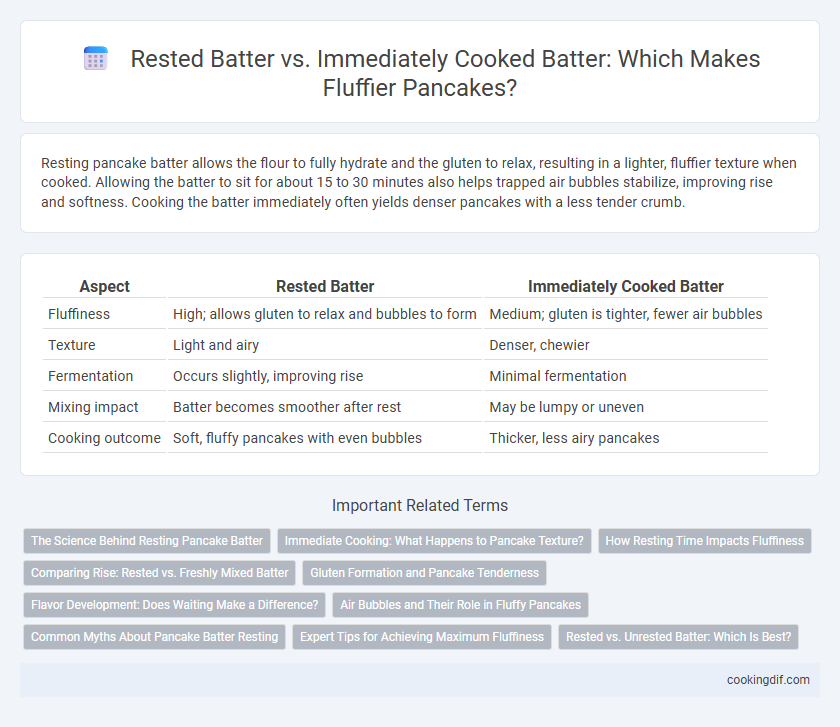Resting pancake batter allows the flour to fully hydrate and the gluten to relax, resulting in a lighter, fluffier texture when cooked. Allowing the batter to sit for about 15 to 30 minutes also helps trapped air bubbles stabilize, improving rise and softness. Cooking the batter immediately often yields denser pancakes with a less tender crumb.
Table of Comparison
| Aspect | Rested Batter | Immediately Cooked Batter |
|---|---|---|
| Fluffiness | High; allows gluten to relax and bubbles to form | Medium; gluten is tighter, fewer air bubbles |
| Texture | Light and airy | Denser, chewier |
| Fermentation | Occurs slightly, improving rise | Minimal fermentation |
| Mixing impact | Batter becomes smoother after rest | May be lumpy or uneven |
| Cooking outcome | Soft, fluffy pancakes with even bubbles | Thicker, less airy pancakes |
The Science Behind Resting Pancake Batter
Resting pancake batter allows gluten strands to relax and the starch granules to hydrate fully, resulting in a tender, fluffy texture when cooked. During this resting period, trapped air bubbles stabilize and leavening agents like baking powder activate, creating a lighter, more voluminous pancake. Immediate cooking prevents these processes, often yielding denser, less airy pancakes with a tougher bite.
Immediate Cooking: What Happens to Pancake Texture?
Immediate cooking of pancake batter results in a denser texture, as the leavening agents like baking powder start reacting only when heat is applied, causing rapid gas release and less time for gluten relaxation. Without resting, the gluten strands remain tighter, preventing the batter from trapping air effectively and leading to less fluffy pancakes. This quick transition from mixing to cooking limits the batter's ability to develop the airy, tender crumb characteristic of fluffy pancakes.
How Resting Time Impacts Fluffiness
Resting pancake batter for at least 30 minutes allows gluten to relax and starch granules to fully hydrate, resulting in a lighter, airier texture when cooked. The resting period also enables leavening agents like baking powder to produce more carbon dioxide bubbles, enhancing the pancake's fluffiness. Batter cooked immediately after mixing often produces denser pancakes due to underdeveloped gluten and insufficient gas formation.
Comparing Rise: Rested vs. Freshly Mixed Batter
Rested pancake batter exhibits significantly better rise compared to freshly mixed batter due to the development of air bubbles and gluten relaxation during the resting period. This results in lighter, fluffier pancakes with a more tender crumb and enhanced texture. Conversely, immediately cooked batter tends to produce denser pancakes with reduced volume and less pronounced lift.
Gluten Formation and Pancake Tenderness
Rested batter allows gluten strands to relax, reducing toughness and resulting in a more tender pancake texture. During rest, hydration of the flour improves, which minimizes excessive gluten development when cooked immediately. This process enhances pancake fluffiness by maintaining a delicate crumb structure and preventing rubbery consistency.
Flavor Development: Does Waiting Make a Difference?
Resting pancake batter allows enzymes to break down starches into simpler sugars, enhancing flavor complexity and creating a naturally sweet profile. The gluten also relaxes during resting, resulting in softer, fluffier pancakes with a more tender crumb texture. Immediate cooking traps raw flour taste and yields denser pancakes with less developed flavor and mouthfeel.
Air Bubbles and Their Role in Fluffy Pancakes
Rested batter allows air bubbles to stabilize and expand, enhancing pancake fluffiness by creating a lighter texture. When batter is cooked immediately, air bubbles remain small and unevenly distributed, resulting in denser pancakes. Proper resting time also activates gluten and leavens the batter, contributing to a soft, airy crumb structure.
Common Myths About Pancake Batter Resting
Resting pancake batter allows gluten strands to relax and starch granules to hydrate, leading to a tender, fluffier texture compared to immediately cooked batter. Common myths suggest that resting for hours is necessary, but research shows that even a 10 to 30-minute rest can significantly improve batter aeration and pancake rise. Overresting beyond this period may cause excessive fermentation, resulting in sour flavors and denser pancakes.
Expert Tips for Achieving Maximum Fluffiness
Resting pancake batter for 10 to 30 minutes allows gluten to relax and starch granules to fully hydrate, resulting in superior fluffiness and tender crumb. Immediate cooking often yields denser pancakes since the batter hasn't had time to develop optimal texture and incorporate air pockets. Expert tips emphasize gently folding the batter to retain air bubbles and using a light hand after resting to maximize lift and achieve the ultimate fluffy pancake.
Rested vs. Unrested Batter: Which Is Best?
Rested batter allows gluten strands to relax and starch granules to fully hydrate, resulting in pancakes that are noticeably fluffier and tender compared to immediately cooked batter. Allowing the batter to rest for 15 to 30 minutes at room temperature improves gas retention during cooking, creating a lighter texture and better rise. In contrast, cooking batter right after mixing often produces denser pancakes with a less airy crumb due to insufficient molecular time to develop optimal texture.
Rested batter vs immediately cooked batter for fluffiness Infographic

 cookingdif.com
cookingdif.com